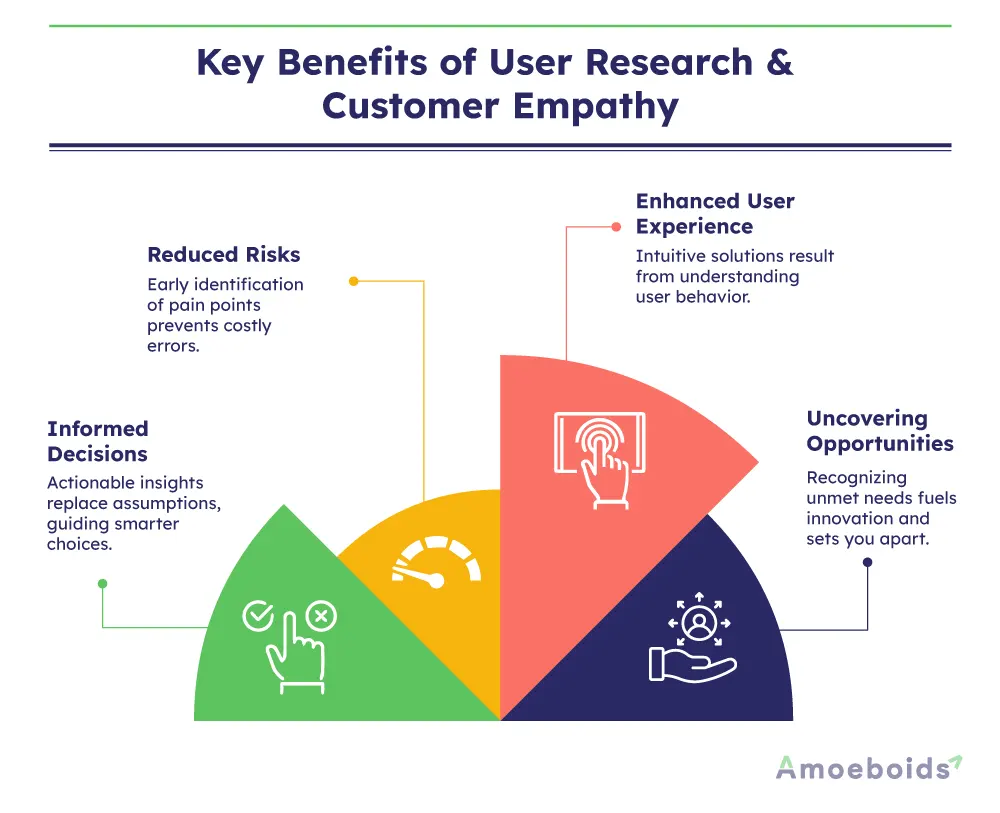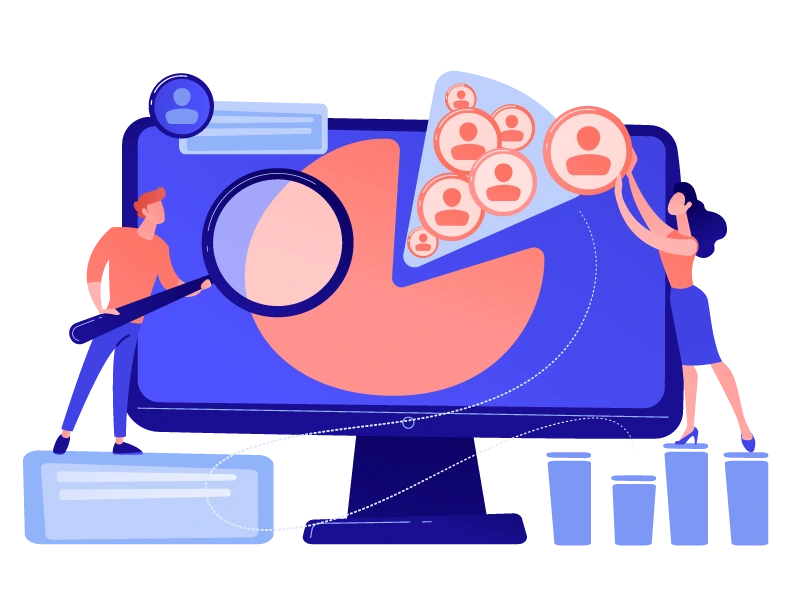As a product manager, understanding your users isn’t just a nice-to-have—it’s a must.
Your ability to empathize with your users can make or break your product. User empathy, the skill of truly understanding & sharing your users’ experiences, is the key to building products that solve real problems & delight customers.
This blog explores how product managers can leverage user research & customer empathy techniques to gain deep insights into their audience, make informed decisions, and create solutions that stand out.
Let’s uncover the tools & techniques that can help you design products your users will love.
But first, let us understand both these concepts briefly.
What is User Research?
User research is the process of uncovering what challenges your users face, how they behave, & what they truly need. It’s about going beyond assumptions to gain actionable insights that inform design & development.
Through methods like surveys, interviews, and usability testing, user research provides a data-driven foundation for understanding users’ preferences & pain points. It ensures that your product decisions are grounded in facts, not guesswork.
But understanding behaviors & needs is just the beginning.
To design solutions that truly resonate, product managers need to go deeper—this is where empathy comes into play.
What is Customer Empathy?
Customer empathy goes beyond the “what” of user research to uncover the “why.”
It’s about stepping into your users’ shoes to understand their emotions, motivations, & frustrations on a personal level.
While user research gives you the facts, empathy allows you to connect those facts to human experiences. Together, they form a powerful combination for creating products that address both functional & emotional gaps.
Why do User research & Customer empathy matter for Product managers?
Product managers are the bridge between users and product teams.
To deliver meaningful solutions, understanding users deeply isn’t optional—it’s essential. User research provides the data to know what users need, while empathy uncovers the why behind their behavior, emotions, and frustrations.
Together, they help you build solutions that truly resonate.
Pairing user research insights with customer empathy reduces guesswork, minimizes development risks, and ensures an ongoing product market fit (PMF). Empathy-driven insights also strengthen customer relationships by showing users that their voices matter.
Ultimately, user research and empathy enable product managers to craft human-centered solutions.
Key benefits of User research & Customer empathy:

- Informed decisions: Replace assumptions with actionable insights for better choices
- Reduced risks: Catch & address pain points early to avoid costly mistakes
- Enhanced user experience: Create solutions that feel intuitive & delightful
- Uncovering opportunities: Identify unmet needs to drive innovation & differentiation
Different types of User research
User research includes a range of techniques that help you understand user needs, verify concepts, and improve your products. Here’s a breakdown of the main types:
- Quantitative research: Focuses on gathering measurable data to validate theories.
It answers questions like “how much,” “how often,” and “how many.”
Examples include A/B testing, web analytics, heatmaps, & surveys. These methods provide numerical insights into user behavior, helping you identify patterns & trends.
- Qualitative research: Investigates the “why” behind user behavior, capturing feedback, preferences, and observations.
It helps uncover non-numerical insights that explain user motivations and emotions. Techniques include user interviews, focus groups, & usability testing.
- Generative research: An exploratory process that combines primary & secondary research to define problems, develop hypotheses, & guide design.
Methods like persona development, journey mapping, & competitive analysis help identify opportunities for innovation & refinement.
- Continuous research: Focuses on regularly collecting user insights to adapt & improve products.
Tools like user feedback surveys, in-app analytics & usage metrics ensure your product stays relevant to evolving user needs & market trends.
- Evaluative research: Validates & refines solutions by testing concepts, designs, or prototypes.
It ensures that products meet user expectations through methods like A/B testing, beta testing, & prototype evaluations.
Types of Customer empathy techniques
One of the key skills in product management is Customer empathy. These techniques help product managers develop a deeper understanding of user needs & emotions. Here are three key approaches:
- Compassionate empathy: Focuses on understanding a customer’s feelings & proactively addressing their needs.
This approach enhances trust by showing users that their challenges are not only understood but also acted upon.
- Cognitive empathy: Is about stepping into the user’s mindset to understand their thought processes & decision-making.
This technique is particularly effective for designing solutions that align closely with user motivations & challenges.
- Emotional empathy: Involves connecting with a user’s emotional state—whether positive or negative.
By identifying and responding to these emotions, product managers can create experiences that feel authentic & meaningful to users.
Techniques for conducting User research and building Customer empathy
Building a user-centric product requires practical techniques that combine research & empathy. Here’s how successful product managers approach these:

Conduct User research
Surveys, interviews, and usability testing are the cornerstones of user research.
Start broad with surveys to identify trends, then dive deeper with interviews to uncover motivations.
Usability testing lets you see firsthand how users interact with your product, highlighting areas for improvement. Combining these methods ensures a balanced perspective on user needs.
Translate insights into Empathy maps
Once you’ve gathered insights, use empathy maps to visualize your users’ experiences.
Start by listing what users think, feel, say, and do. Add emotional triggers & context to understand how their emotions influence behavior.
Empathy maps serve as a shared reference for teams to align on user perspectives.
Shadow users in their environment
Observe users as they interact with your product in real-world settings.
Take note of unspoken frustrations, workarounds, & moments of delight.
Shadowing offers unique insights that can inspire design improvements or uncover hidden opportunities.
Build personas that drive action
Personas turn raw data into relatable user profiles.
Focus on user goals, challenges, and daily routines. For example, include a key frustration or an unmet need that the product aims to address.
Actionable personas guide your team to stay user-focused throughout development.
Use tools to simplify the process
Leverage tailored tools to streamline research & design.
E.g. Hotjar helps analyze user behavior through heatmaps, while SurveyMonkey simplifies feedback collection through surveys. Tools like Figma enable collaborative prototyping & quick iteration, turning insights into tangible outcomes.
By combining these techniques, product managers can go a long way in creating something of value.
Practical tips for applying User research & Customer empathy
Bringing user research & customer empathy into your product management process doesn’t have to be overwhelming. Here are some simple, actionable tips to get started:
Ask Open-Ended Questions
In user interviews, avoid yes/no questions. Instead, ask open-ended questions like:
- Can you describe a time when this feature helped you achieve your goal?
- What was the most frustrating part of using the feature?
Such questions encourage users to share deeper insights, often revealing pain points & unmet needs.
Combine qualitative & quantitative insights
Use qualitative methods, like interviews & usability testing, to understand the “why” behind user behavior. Then validate your findings with quantitative data, like survey results or analytics.
This blend ensures a well-rounded understanding.
Involve stakeholders early
Empathy isn’t just for product managers—it’s a team effort.
Share your research findings with designers, engineers, & other stakeholders early in the process. Use tools like empathy maps or personas to create alignment and foster shared understanding.
Iterate with user feedback
Bring users into the development process by seeking their help in testing prototypes or early designs.
Their feedback helps you refine features & avoid costly redesigns later.
Stay curious & challenge assumptions
Approach every interaction with a learning mindset.
Let user insights challenge your preconceptions & guide you toward better solutions. The more curious you are, the more likely you’ll uncover hidden opportunities.
Conclusion
User research & customer empathy are the foundation of successful product management. By deeply understanding your users’ needs, motivations, and emotions, you can build products that not only solve problems but also delight your audience.
So, start small—conduct a few interviews, create an empathy map, or shadow a user for a day. These steps can transform how you approach product development and build stronger connections with your users.
Remember, great products begin with great understanding.
Make user research and empathy your superpowers & watch your products—and your user relationships—thrive.



